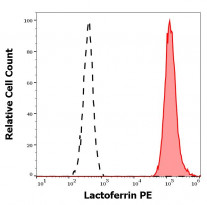ARG42448
anti-Lactoferrin antibody [LF5-1D2] (PE)
anti-Lactoferrin antibody [LF5-1D2] (PE) for Flow cytometry and Human
Overview
| Product Description | PE-conjugated Mouse Monoclonal antibody [LF5-1D2] recognizes Lactoferrin |
|---|---|
| Tested Reactivity | Hu |
| Tested Application | FACS |
| Specificity | The mouse monoclonal antibody LF5-1D2 recognizes lactoferrin, an iron-binding secreted glycoprotein of about 90 kDa, which has anti-inflammatory, immunomodulatory and anti-microbial properties. |
| Host | Mouse |
| Clonality | Monoclonal |
| Clone | LF5-1D2 |
| Isotype | IgG1 |
| Target Name | Lactoferrin |
| Antigen Species | Human |
| Immunogen | Human Lactoferrin. |
| Conjugation | PE |
| Alternate Names | LF; Lfcin-H; HEL110; Lactoferrin; Lactotransferrin; Growth-inhibiting protein 12; GIG12; Talalactoferrin; EC 3.4.21.-; HLF2 |
Application Instructions
| Application Suggestion |
|
||||
|---|---|---|---|---|---|
| Application Note | * The dilutions indicate recommended starting dilutions and the optimal dilutions or concentrations should be determined by the scientist. |
Properties
| Form | Liquid |
|---|---|
| Purification | Purified |
| Buffer | PBS and 15 mM Sodium azide. |
| Preservative | 15 mM Sodium azide |
| Storage Instruction | Aliquot and store in the dark at 2-8°C. Keep protected from prolonged exposure to light. Avoid repeated freeze/thaw cycles. Suggest spin the vial prior to opening. The antibody solution should be gently mixed before use. |
| Note | For laboratory research only, not for drug, diagnostic or other use. |
Bioinformation
| Database Links | |
|---|---|
| Gene Symbol | LTF |
| Gene Full Name | lactotransferrin |
| Background | This gene is a member of the transferrin family of genes and its protein product is found in the secondary granules of neutrophils. The protein is a major iron-binding protein in milk and body secretions with an antimicrobial activity, making it an important component of the non-specific immune system. The protein demonstrates a broad spectrum of properties, including regulation of iron homeostasis, host defense against a broad range of microbial infections, anti-inflammatory activity, regulation of cellular growth and differentiation and protection against cancer development and metastasis. Antimicrobial, antiviral, antifungal and antiparasitic activity has been found for this protein and its peptides. Alternatively spliced transcript variants encoding different isoforms have been found for this gene. [provided by RefSeq, Sep 2014] |
| Function | Transferrins are iron binding transport proteins which can bind two Fe(3+) ions in association with the binding of an anion, usually bicarbonate. Lactotransferrin is a major iron-binding and multifunctional protein found in exocrine fluids such as breast milk and mucosal secretions. Has antimicrobial activity, which depends on the extracellular cation concentration. Antimicrobial properties include bacteriostasis, which is related to its ability to sequester free iron and thus inhibit microbial growth, as well as direct bactericidal properties leading to the release of lipopolysaccharides from the bacterial outer membrane. Can also prevent bacterial biofilm development in P.aeruginosa infection. Has weak antifungal activity against C.albicans. Has anabolic, differentiating and anti-apoptotic effects on osteoblasts and can also inhibit osteoclastogenesis, possibly playing a role in the regulation of bone growth. Promotes binding of species C adenoviruses to epithelial cells, promoting adenovirus infection. Can inhibit papillomavirus infections. Stimulates the TLR4 signaling pathway leading to NF-kappa-B activation and subsequent pro-inflammatory cytokine production while also interfering with the lipopolysaccharide (LPS)-stimulated TLR4 signaling. Inhibits neutrophil granulocyte migration to sites of apoptosis, when secreted by apoptotic cells. Stimulates VEGFA-mediated endothelial cell migration and proliferation. Binds heparin, chondroitin sulfate and possibly other glycosaminoglycans (GAGs). Also binds specifically to pneumococcal surface protein A (pspA), the lipid A portion of bacterial lipopolysaccharide (LPS), lysozyme and DNA. Lactoferricin binds to the bacterial surface and is crucial for the bactericidal functions. Has some antiviral activity against papillomavirus infection. N-terminal region shows strong antifungal activity against C.albicans. Contains two BBXB heparin-binding consensus sequences that appear to form the predominate functional GAG-binding site. Kaliocin-1 has antimicrobial activity and is able to permeabilize different ions through liposomal membranes. Lactoferroxins A, B and C have opioid antagonist activity. Lactoferroxin A shows preference for mu-receptors, while lactoferroxin B and C have somewhat higher degrees of preference for kappa-receptors than for mu-receptors. The lactotransferrin transferrin-like domain 1 functions as a serine protease of the peptidase S60 family that cuts arginine rich regions. This function contributes to the antimicrobial activity. Shows a preferential cleavage at -Arg-Ser-Arg-Arg-|- and -Arg-Arg-Ser-Arg-|-, and of Z-Phe-Arg-|-aminomethylcoumarin sites. [Isoform DeltaLf]: transcription factor with antiproliferative properties and ability to induce cell cycle arrest. Binds to the DeltaLf response element found in the SKP1, BAX, DCPS, and SELENOH promoters. [UniProt] |
| Cellular Localization | Isoform 1: Secreted. Cytoplasmic granule. Note=Secreted into most exocrine fluids by various endothelial cells. Stored in the secondary granules of neutrophils. Isoform DeltaLf: Cytoplasm. Nucleus. Note=Mainly localized in the cytoplasm. [UniProt] |
| Calculated MW | 78 kDa |
| PTM | Isoform DeltaLf: Ubiquitinated at Lys-379 and Lys-391. Poly-N-acetyllactosaminic carbohydrate moiety seems to be needed for TLR4 activation. [UniProt] |
Images (2) Click the Picture to Zoom In
-
ARG42448 anti-Lactoferrin antibody [LF5-1D2] (PE) FACS image
Flow Cytometry: Human peripheral whole blood stained with ARG42448 anti-Lactoferrin antibody [LF5-1D2] (PE) at 10 µl / 100 µl of peripheral whole blood.
-
ARG42448 anti-Lactoferrin antibody [LF5-1D2] (PE) FACS image
Flow Cytometry: Separation of Human neutrophil granulocytes (red-filled) from lymphocytes (black-dashed). Human peripheral whole blood stained with ARG42448 anti-Lactoferrin antibody [LF5-1D2] (PE) at 10 µl / 100 µl of peripheral whole blood.







